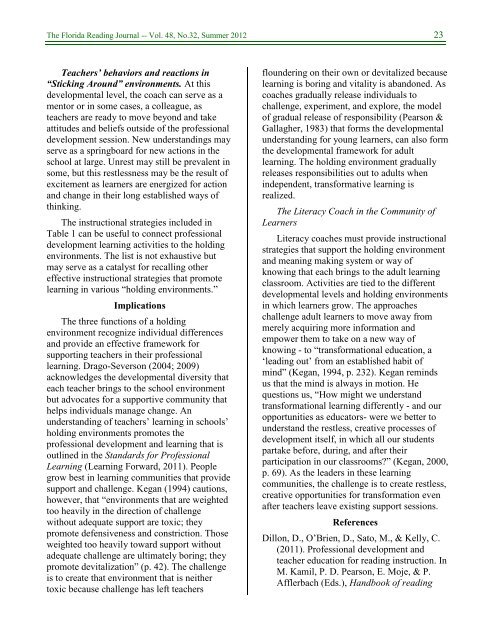PDF (Adobe Reader) - Florida Reading Association
PDF (Adobe Reader) - Florida Reading Association
PDF (Adobe Reader) - Florida Reading Association
You also want an ePaper? Increase the reach of your titles
YUMPU automatically turns print PDFs into web optimized ePapers that Google loves.
The <strong>Florida</strong> <strong>Reading</strong> Journal -- Vol. 48, No.32, Summer 2012 23<br />
Teachers’ behaviors and reactions in<br />
“Sticking Around” environments. At this<br />
developmental level, the coach can serve as a<br />
mentor or in some cases, a colleague, as<br />
teachers are ready to move beyond and take<br />
attitudes and beliefs outside of the professional<br />
development session. New understandings may<br />
serve as a springboard for new actions in the<br />
school at large. Unrest may still be prevalent in<br />
some, but this restlessness may be the result of<br />
excitement as learners are energized for action<br />
and change in their long established ways of<br />
thinking.<br />
The instructional strategies included in<br />
Table 1 can be useful to connect professional<br />
development learning activities to the holding<br />
environments. The list is not exhaustive but<br />
may serve as a catalyst for recalling other<br />
effective instructional strategies that promote<br />
learning in various “holding environments.”<br />
Implications<br />
The three functions of a holding<br />
environment recognize individual differences<br />
and provide an effective framework for<br />
supporting teachers in their professional<br />
learning. Drago-Severson (2004; 2009)<br />
acknowledges the developmental diversity that<br />
each teacher brings to the school environment<br />
but advocates for a supportive community that<br />
helps individuals manage change. An<br />
understanding of teachers‟ learning in schools‟<br />
holding environments promotes the<br />
professional development and learning that is<br />
outlined in the Standards for Professional<br />
Learning (Learning Forward, 2011). People<br />
grow best in learning communities that provide<br />
support and challenge. Kegan (1994) cautions,<br />
however, that “environments that are weighted<br />
too heavily in the direction of challenge<br />
without adequate support are toxic; they<br />
promote defensiveness and constriction. Those<br />
weighted too heavily toward support without<br />
adequate challenge are ultimately boring; they<br />
promote devitalization” (p. 42). The challenge<br />
is to create that environment that is neither<br />
toxic because challenge has left teachers<br />
floundering on their own or devitalized because<br />
learning is boring and vitality is abandoned. As<br />
coaches gradually release individuals to<br />
challenge, experiment, and explore, the model<br />
of gradual release of responsibility (Pearson &<br />
Gallagher, 1983) that forms the developmental<br />
understanding for young learners, can also form<br />
the developmental framework for adult<br />
learning. The holding environment gradually<br />
releases responsibilities out to adults when<br />
independent, transformative learning is<br />
realized.<br />
The Literacy Coach in the Community of<br />
Learners<br />
Literacy coaches must provide instructional<br />
strategies that support the holding environment<br />
and meaning making system or way of<br />
knowing that each brings to the adult learning<br />
classroom. Activities are tied to the different<br />
developmental levels and holding environments<br />
in which learners grow. The approaches<br />
challenge adult learners to move away from<br />
merely acquiring more information and<br />
empower them to take on a new way of<br />
knowing - to “transformational education, a<br />
„leading out‟ from an established habit of<br />
mind” (Kegan, 1994, p. 232). Kegan reminds<br />
us that the mind is always in motion. He<br />
questions us, “How might we understand<br />
transformational learning differently - and our<br />
opportunities as educators- were we better to<br />
understand the restless, creative processes of<br />
development itself, in which all our students<br />
partake before, during, and after their<br />
participation in our classrooms” (Kegan, 2000,<br />
p. 69). As the leaders in these learning<br />
communities, the challenge is to create restless,<br />
creative opportunities for transformation even<br />
after teachers leave existing support sessions.<br />
References<br />
Dillon, D., O‟Brien, D., Sato, M., & Kelly, C.<br />
(2011). Professional development and<br />
teacher education for reading instruction. In<br />
M. Kamil, P. D. Pearson, E. Moje, & P.<br />
Afflerbach (Eds.), Handbook of reading



